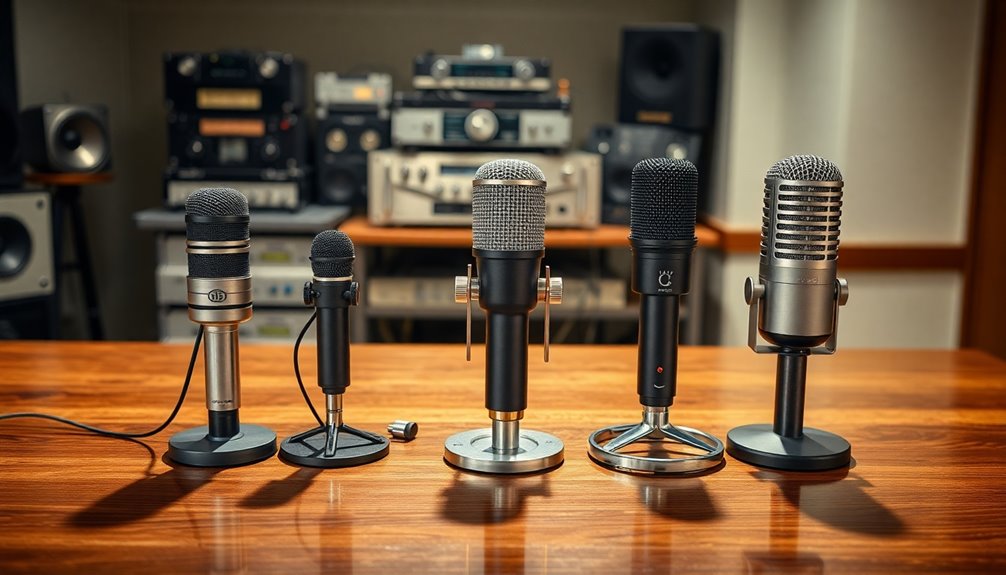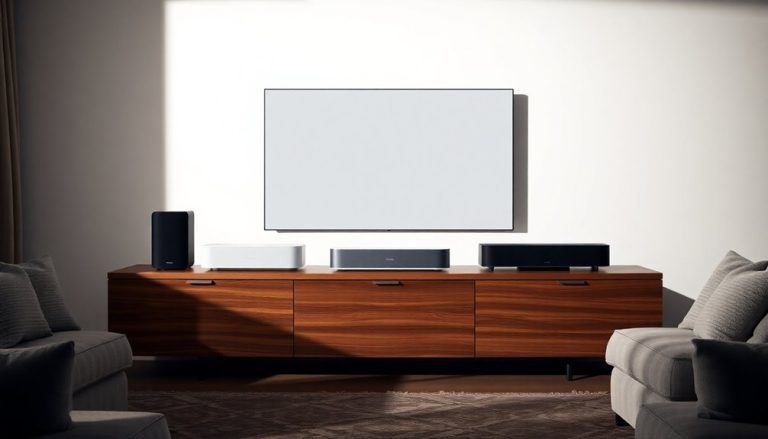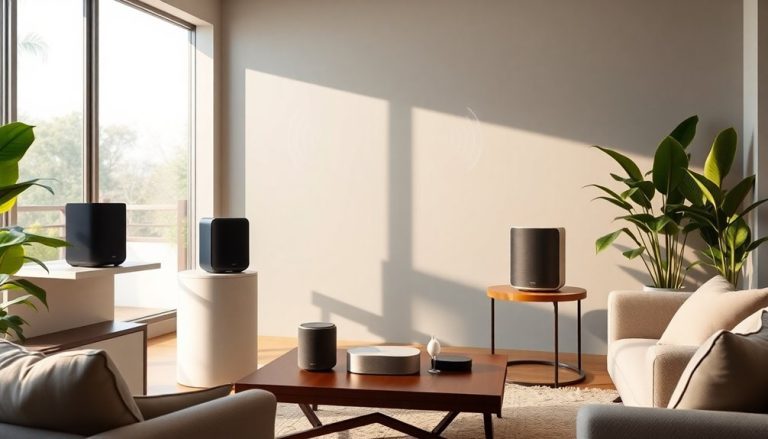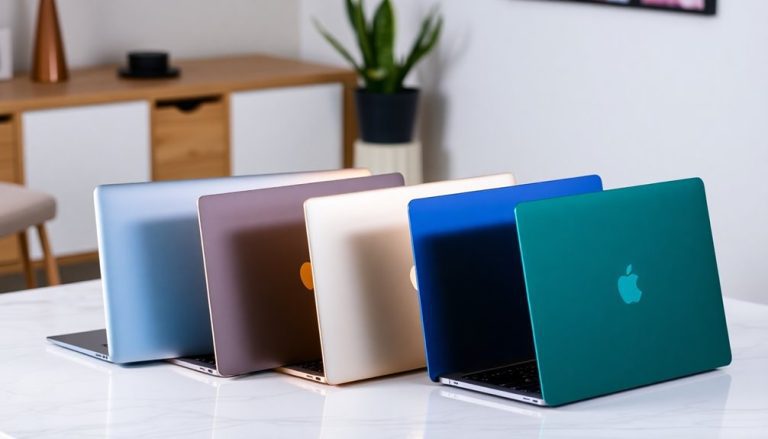In 2025, you've got fantastic microphone options for every budget and need. For podcasting, try the MAONO USB Microphone Kit. The Mini Mic Pro Wireless is great for on-the-go recording with your smartphone. Need a reliable handheld option? Check out the Marengo Handheld Mic. For a wireless setup, the JBL Wireless Two Microphone System offers flexibility and convenience. Gamers will love the MAONO Gaming USB Microphone that features noise cancellation. Each option balances performance and price, ensuring you'll find something that fits perfectly. Stick around to discover more details about these top picks!
Key Takeaways
- Best Value Option: The Audio-Technica AT2020 offers excellent sound quality for under $100, suitable for beginners and home studio setups.
- Professional Choice: The Shure SM7B is a top-tier dynamic microphone, ideal for studio recordings and live performances, priced around $400.
- Versatile USB Mic: The Blue Yeti is a popular USB microphone perfect for streaming and podcasting, featuring multiple polar patterns and easy plug-and-play functionality.
- Compact and Convenient: The Rode Wireless Go II lavalier microphone system provides wireless freedom for interviews and presentations, with reliable audio quality at a mid-range price.
- Budget-Friendly Lavalier: The Movo LV1 is an affordable lavalier microphone option under $50, ideal for mobile devices and basic recording needs.
MAONO USB Microphone Kit for PC and Podcasting
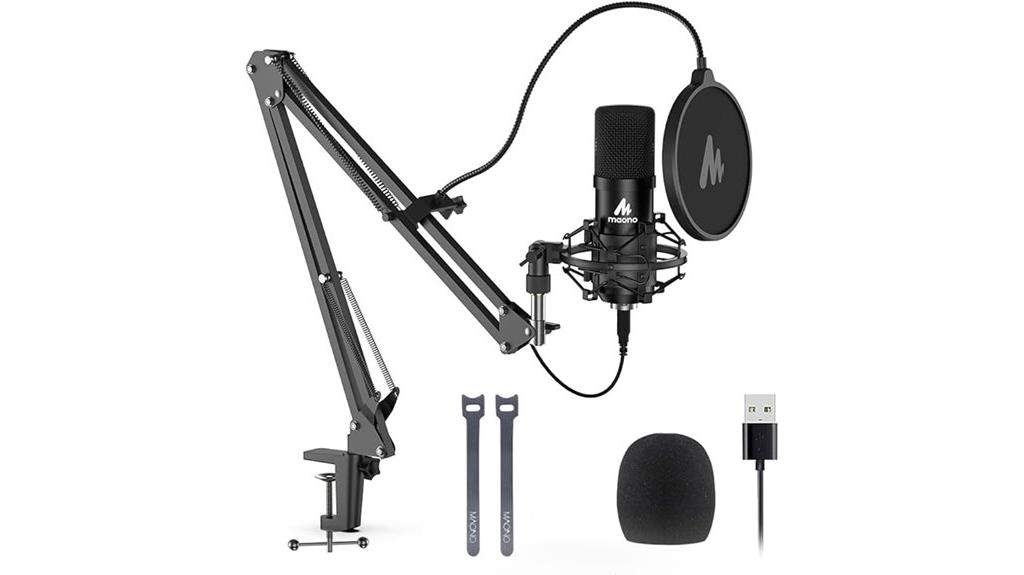
If you're a content creator looking for a reliable and high-quality microphone, the MAONO USB Microphone Kit for PC and Podcasting is an excellent choice for you. This USB microphone boasts a professional sound chipset with a sampling rate of 192kHz/24bit, ensuring crystal-clear audio for your recordings, gaming sessions, or YouTube videos. Its cardioid polar pattern effectively minimizes background noise, making it perfect for podcasts and voiceovers. Plus, setup is a breeze with plug-and-play functionality—no additional drivers needed. The kit includes essential accessories like a sturdy boom arm, pop filter, and shock mount, enhancing your audio capture. With an average rating of 4.5 stars, users rave about its sound quality and value for money, making it a top pick for beginners.
Best For: Content creators, beginners, and podcasters seeking an affordable, high-quality microphone solution.
Pros:
- Excellent sound quality with a professional sound chipset and high sampling rate.
- Easy setup with plug-and-play functionality—no drivers required.
- Comprehensive kit includes essential accessories like a boom arm, pop filter, and shock mount.
Cons:
- Boom arm stability could be improved according to some user feedback.
- Soundproofing may be necessary in recording environments to optimize audio quality.
- Compatibility with mobile devices requires an additional OTG adapter.
Mini Mic Pro Wireless Microphone for iPhone and Android (2 Pack)
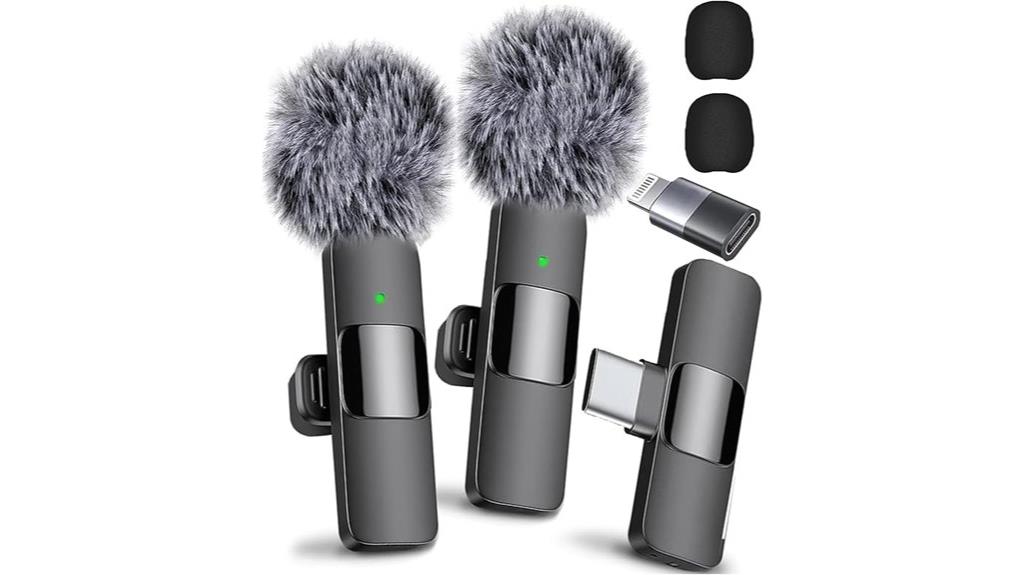
The Mini Mic Pro Wireless Microphone for iPhone and Android (2 Pack) is the perfect choice for content creators seeking a compact and reliable audio solution. With its omnidirectional sound reception and high-sensitivity microphone, you'll capture crystal-clear audio thanks to its 2.4GHz digital transmission. Enjoy a generous range of up to 260 meters, making it ideal for various recording scenarios. The built-in intelligent noise reduction ensures quality sound, while the rechargeable transmitter and receiver last around six hours. Weighing just 2.89 ounces, it's lightweight and easy to set up. Although it's well-rated for casual use, be mindful of potential battery life issues and occasional disconnections in crowded environments. Overall, it's a solid choice for social media content creation.
Best For: Content creators and casual users looking for a compact, easy-to-use wireless microphone for mobile devices.
Pros:
- Crystal clear audio quality with 2.4GHz digital transmission and intelligent noise reduction.
- Lightweight and portable design, making it easy to carry and set up for various recording scenarios.
- Generous range of up to 260 meters, allowing for versatile recording distances.
Cons:
- Battery life concerns reported by users, with potential reliability issues.
- Occasional disconnections in crowded environments, affecting recording stability.
- Not suitable for professional recordings, as it may not meet higher audio quality standards.
Marengo Handheld Wired Microphone with 13ft Cable
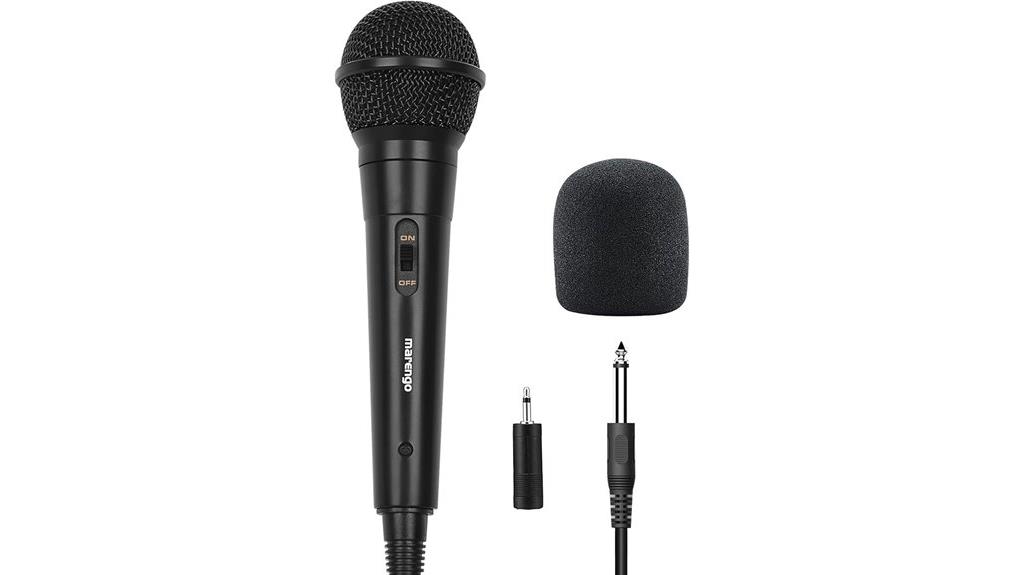
Designed for both amateur and professional vocalists, the Marengo Handheld Wired Microphone with a 13ft cable is an excellent choice for anyone seeking high-quality sound in various settings. This cardioid dynamic microphone captures your voice clearly while filtering out unwanted noise, making it perfect for live performances or recording. Weighing just 12.3 ounces, its solid and durable construction ensures it withstands regular use. The comfortable grip adds to your ease during long sessions. You'll appreciate its compatibility with various devices, thanks to the included 1/4 inch jack and adapter. With a customer rating of 4.2 out of 5 stars, the Marengo microphone is a reliable option for KTV, meetings, and small gatherings.
Best For: The Marengo Handheld Wired Microphone is best for amateur and professional vocalists seeking high-quality sound in both live performance and recording settings.
Pros:
- Premium sound quality with cardioid pickup pattern effectively filters unwanted noise.
- Durable construction ensures longevity, making it suitable for regular use in various environments.
- Versatile compatibility with devices featuring 1/4 or 1/8 mic inputs, ideal for KTV, meetings, and small events.
Cons:
- Some users reported volume limitations when used with specific devices.
- May require additional amplification for larger events to achieve desired sound levels.
- Limited frequency response at 15 KHz may not meet the needs of all professional applications.
JBL Wireless Two Microphone System with Dual-Channel Receiver, Black
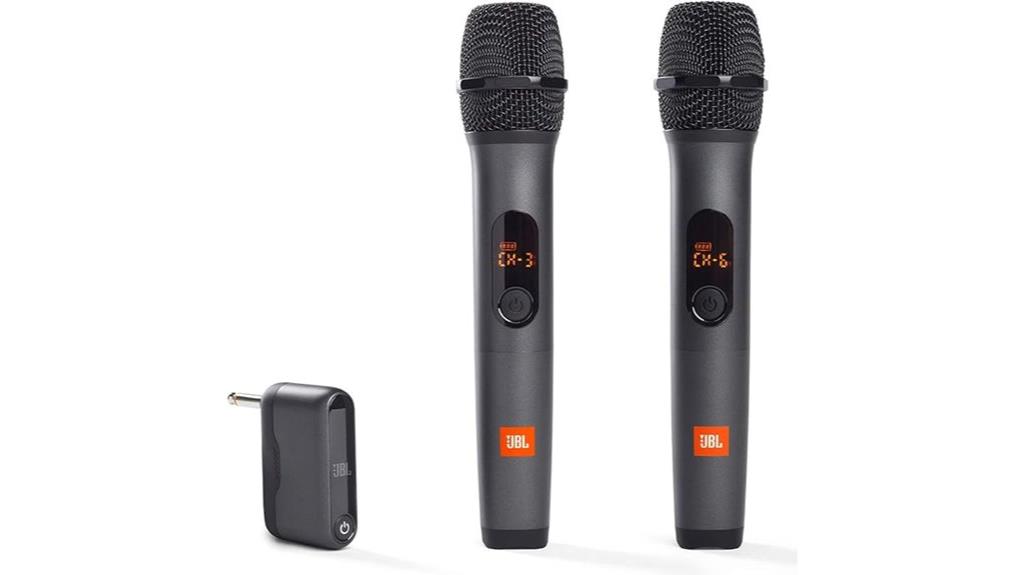
For anyone looking to enhance their live performances or karaoke nights, the JBL Wireless Two Microphone System with Dual-Channel Receiver stands out as a top choice in 2025. This system pairs effortlessly with JBL PartyBox speakers and any mic-compatible audio gear. With a rechargeable UHF dual-channel receiver, you can connect two microphones for up to 6 hours of playtime. The plug-and-play setup means you just turn it on and start singing. Users rave about the crystal-clear sound quality and impressive wireless range, allowing you to move freely without losing connection. While it's a higher investment, the durability and exceptional audio clarity make it worth it, especially for events where performance matters.
Best For: This microphone system is best for performers, karaoke enthusiasts, and event hosts seeking high-quality audio and reliability during live events.
Pros:
- Clear and crisp sound quality with minimal distortion.
- Strong wireless range, allowing freedom of movement without signal drops.
- Quick and easy plug-and-play setup for instant use.
Cons:
- Higher price point compared to other microphone options.
- Battery life is decent but may benefit from improvements; spare batteries are recommended.
- Initial setup may require careful attention for those unfamiliar with audio equipment.
MAONO Gaming USB Microphone with Noise Cancellation and Boom Arm
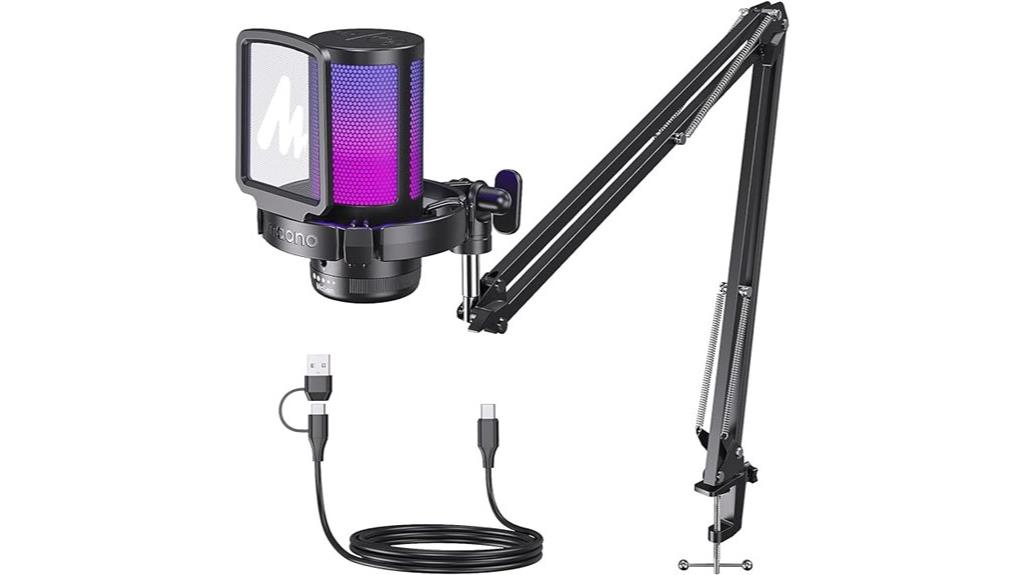
Gamers and streamers looking for an edge in audio quality will find the MAONO Gaming USB Microphone a top contender in 2025. Its one-click noise cancellation effectively blocks background distractions, ensuring your voice stands out. With a cardioid pickup pattern and impressive frequency range of 50-200 KHz, you'll enjoy crystal-clear audio. Quick controls like a mute button and gain knob make adjustments seamless, while zero-latency monitoring enhances your recording experience.
The stylish design features customizable RGB lighting, adding flair to your setup. Plus, it's easy to set up—just plug it into your Windows PC, Mac, or PS4/PS5, and you're ready to go. The included boom arm lets you position the microphone perfectly, maximizing your gaming experience.
Best For: Gamers and streamers seeking high-quality audio with effective noise cancellation and customizable features.
Pros:
- Excellent noise cancellation technology enhances voice clarity.
- Easy plug-and-play setup compatible with multiple devices.
- Customizable RGB lighting adds aesthetic appeal to gaming setups.
Cons:
- Build primarily from plastic may not appeal to all users.
- Some users may find the RGB lighting distracting during gameplay.
- Limited to USB connectivity, which may not suit all setups.
Factors to Consider When Choosing Microphones
When you're choosing a microphone, several key factors can make or break your decision. You'll want to consider sound quality, the type of connectivity options available, and the specific microphone type that fits your needs. Don't forget to factor in your budget and how you'll use the microphone to ensure you pick the right one.
Sound Quality Importance
Choosing the right microphone is essential for ensuring high-quality sound, especially since it directly influences how your audience perceives your content. Sound quality is critical in applications like podcasts, video recordings, and live performances, as it shapes the listener's experience.
When selecting a microphone, pay attention to the signal-to-noise ratio (SNR). A microphone with an SNR of 120 dB or higher provides clearer audio by minimizing background noise, making it ideal for professional settings. Additionally, consider the frequency response range, typically measured in Hertz (Hz). A broad range, such as 30Hz-16kHz, ensures accurate capture of various audio frequencies.
You should also look for microphones with cardioid polar patterns, which focus on sound from the front while reducing ambient noise from the sides and rear. This feature is especially useful in noisy environments. Finally, consider options with noise cancellation technology. This can significantly enhance audio clarity by filtering out extraneous sounds, making it particularly beneficial for streaming and gaming contexts.
Connectivity Options Available
Sound quality isn't the only factor to keep in mind; connectivity options play a significant role in how you use your microphone. First, consider USB microphones. They offer plug-and-play functionality, making them compatible with PCs, laptops, and mobile devices without needing extra drivers. This convenience can save you time and frustration.
Next, think about wireless microphones. These typically use UHF or 2.4GHz frequencies, giving you freedom of movement and reducing cable clutter. This option is perfect if you need to move around while recording or performing, all while maintaining excellent audio quality over distances.
You should also look for microphones with a 1/4 inch jack or adapters for 1/8 inch connections. This feature ensures compatibility with standard audio equipment, such as mixers and amplifiers, making it easier to integrate into your existing setup.
Additionally, some models come with built-in converters for USB-C or regular USB connections. This can simplify the setup process, especially if you switch between different devices. Lastly, if you're considering lavalier microphones, they often connect directly to mobile devices, providing hands-free recording options for interviews or presentations.
Microphone Type Selection
Selecting the right microphone type is crucial for achieving optimal audio quality in your recordings. You'll typically choose between dynamic, condenser, or lavalier microphones, each tailored for different recording environments. If you're performing live, dynamic mics are your best bet, as they handle high sound pressure levels exceptionally well. For studio settings, condenser mics excel, capturing a broader frequency range and finer details.
Consider the microphone's pickup pattern, too. Cardioid mics are particularly effective at minimizing background noise, focusing on sound directly in front of them. If you need to capture sound from all directions, an omnidirectional pattern may suit your needs better.
You should also pay attention to frequency response, which indicates the range of sounds the mic can accurately capture. For example, a studio condenser mic might have a range of 30Hz to 16kHz, covering most musical instruments and vocals. Lastly, look at the signal-to-noise ratio (SNR), which measures the desired audio signal against background noise; a higher SNR means clearer sound. By weighing these factors, you'll find the microphone that best fits your recording needs.
Budget Considerations
When it comes to finding the right microphone, your budget plays a pivotal role in narrowing down your options. Prices can range widely, with affordable models under $50 and high-end options exceeding $200. Start by determining your budget range, as this will help you focus on the best choices available.
Look for average customer ratings to gauge value for money. Products with ratings above 4.0 stars generally indicate user satisfaction, so consider these as you compare options. Additionally, remember to assess the total cost of ownership. Accessories like boom arms, pop filters, or extra cables can add to your initial spending, so factor those in.
Aim for microphones that strike a balance between features and performance within your budget. Higher-priced models often offer advanced specifications, such as improved sound quality and noise cancellation. Lastly, don't overlook warranty and customer support options. Products within the same price range can differ significantly in after-purchase assistance and reliability, so choose wisely. By considering these factors, you can make an informed decision that fits both your needs and your wallet.
Usage Scenarios
Your choice of microphone should align closely with how you plan to use it, as different scenarios demand specific features. For podcasting and voiceovers, look for microphones with a cardioid polar pattern. These help minimize background noise, ensuring your voice remains clear, especially if the mic has a signal-to-noise ratio of 120 dB or higher.
If you're performing live, opt for handheld dynamic microphones. A solid build with a cardioid pickup pattern is crucial to capture your vocals while filtering out unwanted sounds. Aim for models that feature a frequency response up to 15 kHz for optimal audio fidelity.
For video recording or interviews, wireless lavalier microphones offer the freedom to move around while maintaining high-quality audio, often with a range of up to 260 meters.
Gamers and streamers should consider USB microphones equipped with noise cancellation and adjustable gain controls, as these features improve audio quality in distracting environments.
Finally, think about power source requirements. Battery-powered options provide mobility, while USB-powered microphones allow for straightforward plug-and-play functionality with your computer. Choosing the right microphone based on your specific needs is key to achieving the best audio results.
Portability and Weight
In today's fast-paced world, portability and weight are vital factors to consider when choosing a microphone. If you're frequently on the go, lightweight models weighing less than 1 pound are ideal, as they're easy to carry and quick to set up. Compact designs, like lavalier microphones, are also a great choice since they measure only a few inches, making them perfect for discreet recording and travel.
When evaluating microphones, think about the cable length too. Wired microphones with longer cables, such as 13 feet, offer flexibility in positioning but can be cumbersome to transport. Wireless microphones, on the other hand, enhance portability by eliminating cables, allowing you greater freedom and movement during use.
However, keep in mind that the weight of a microphone can impact its stability. Heavier models might require additional support or stands to maintain balance, especially in dynamic settings. Ultimately, choosing a microphone that balances portability and weight will ensure you have the right tool for your recording needs, making your experience smoother and more efficient wherever you are.
Additional Features Offered
Choosing the right microphone involves considering additional features that can enhance your recording experience. Noise cancellation is a game-changer, especially for gaming and streaming, as it filters out background sounds, ensuring your voice comes through crystal clear. If you want to control your audio levels, look for microphones with adjustable gain knobs. They allow you to tailor your voice levels to suit different recording environments.
Visual appeal matters too. RGB lighting customization can make your setup pop, creating a cohesive look that matches your gaming or recording gear. Plus, don't overlook plug-and-play functionality; it simplifies the setup process, letting you start recording or streaming immediately without fussing over drivers or complicated configurations.
Finally, consider accessories like boom arms, pop filters, and shock mounts. These can improve your audio quality by stabilizing the microphone and minimizing unwanted noise during recordings. With these additional features in mind, you can choose a microphone that not only meets your technical needs but also enhances your overall recording experience.
Frequently Asked Questions
What Is the Ideal Microphone Type for Vocal Recording?
For vocal recording, you'll want a condenser microphone. Its sensitivity captures nuances and details in your voice, making it perfect for studio settings. Dynamic mics work too, especially for live performances, but they might lack clarity.
How Do I Maintain My Microphone for Optimal Performance?
To maintain your microphone for optimal performance, regularly clean the grill, check cables for wear, store it properly, and avoid extreme temperatures. Also, use a pop filter to minimize moisture and plosive sounds during recordings.
Can I Use a Microphone for Live Streaming?
Absolutely, you can use a microphone for live streaming! It enhances your audio quality, making your stream more engaging. Just ensure it's compatible with your streaming setup, and you're good to go!
What Are the Differences Between Dynamic and Condenser Microphones?
Dynamic microphones excel in handling high sound pressure levels and are durable, making them great for live performances. Condenser microphones, on the other hand, capture more detail and are ideal for studio recordings and vocals.
How Do I Reduce Background Noise When Recording?
To reduce background noise when recording, use a directional microphone, position it close to your sound source, and choose a quiet space. You can also apply noise reduction software during post-production for cleaner audio.
Conclusion
In 2025, finding the right microphone doesn't have to be overwhelming. Whether you're podcasting, gaming, or performing, there's a perfect option for you on this list that suits your budget and needs. From the versatile MAONO kits to the portable Mini Mic Pro, each microphone delivers quality sound and functionality. So, consider your specific requirements and pick the one that fits your style best. Happy recording!
